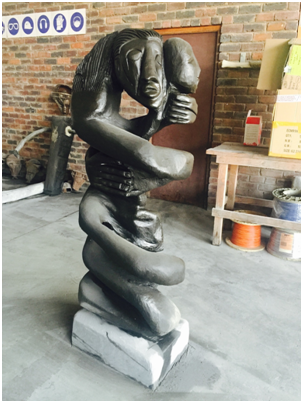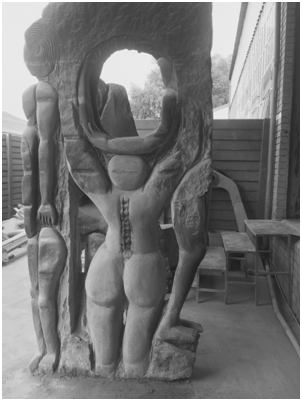Born in Springs, situated east of Johannesburg, Pitika Ntuli grew up with a keen interest in art. As a young man, he got involved in politics, and he was an active member of the struggle against the apartheid government to which resulted in him being exiled from South Africa. He arrived in the UK in 1978, after having spent a year in solitary isolation in a death row prison cell in Swaziland. Ntuli was released into exile due to international pressure that was placed on the South African and Swaziland authorities. Not long after his arrival in the UK, Ntuli immersed himself in the culture and became an active member as he engaged with the politics and general cultures of both his home and host countries.[1]
Ntuli left the UK to study at the Pratt Institute in New York, USA, where he received a Masters of Fine Arts and a Masters of Arts in Comparative Industrial Relations and Industrial Sociology. Upon completion he returned to England and began his teaching career, teaching at such institutions as the Camberwell College of Art, Central Saint Martins College of Art and Design, The London College of Printing, Middlesex University and the University of East London, lecturing in Fine Art and English Literature.[2]
Exhibitions and Work
Ntuli has worked with a number of organisations such as Amnesty International - which is a global organisation that runs campaigns against the abuse of Human rights and promotes social change, such as the campaign that saw the end of the death penalty in many countries. He has also been involved with Index-on-censorship, a magazine that focuses on the freedom of expression that often has podcasts and projects that promote artistic and political dialogue.[3]
In addition to his involvement in existing organisations, he was also very instrumental in establishing a number of art movements and institutions, namely Apples & Snakes, one of Europe’s leading poetry circuits based in London[4] , as well as the development of Jenako Arts, which was a multi disciplinary arts center that promoted the arts and culture of Africa, Asia and the Caribbean. Jenako Arts, which has since been dissolved, was based in Stoke Newington and would host a number of workshops that encouraged the participation of local and surrounding communities with an international art base in an attempt to promote a cross cultural set of interactions between people.[5]
He returned to South Africa in 1994 and went straight into a job lecturing in the Fine Art Department at Wits University for a year, afterwhich he went on to lecture at University of KwaZulu-Natal. During this time he continued to work with artists, both locally and internationally, to promote art in South Africa.[6]
He has exhibited in a number of shows across Europe and the US, and many of his sculptures can be found in private as well as public art collections. He has received international acclaim however his first exhibition in South Africa wasn’t until his 2010 show titled Scent of Invisible Footprints - In moments of Complexity which opened on the 20 May at Museum Africa in Newtown, Johannesburg.
On display were 180 sculptures made from found objects, to various industrial materials. The exhibition also included a collection of Ntuli’s poems and highlighted the sentiment of the sculptures. Images of the sculptures were later published in a book of the same title whilst the poems were published in a book titled The Poetry (2014). Ntuli uses symbolism between his African heritage and modern Western values to create a dialogue. He is said to be an artist that is able to combine different mediums as well as narratives to create a visually articulate set of ideas that often cannot be categorised into one box. His work has multiple dimensions that urge the viewer to challenge perceptions of representation, whilst considering the relationship between art, politics and culture as a whole. His work has been received as both challenging and entertaining.[7]
In January of 2013 Ntuli unveiled a monument in Soweto that was created in honour of the Silverton Three; Stephen Mafoko, Humphrey Makhubo and Wilfred Madela. The three men who were cadres of www.businesslive.co.zaUmkhonto We Sizwe, were shot and killed by police on the 25th of January in 1980 whilst carrying out an MK sabotage mission to Watloo, Pretoria. The men had taken refuge in a bank in Silverton after realising that they were being followed, and ended up embroiled in a hostage situation with 25 civilians. Many demands were made, among them was the release of Nelson Mandela from prison. After long negotiations, a police unit stormed the bank and the three men were shot and killed along with two hostages.[8]
Ntuli has described the six-meter long structure as an “anti-monument” as it is fixed, yet the shadows that are cast as by the sun during the day create an ever changing story that depicts the vulnerability, triumph and struggles that the men faced in their fight for freedom. According to Ntuli, this work is a representation of how the object of art itself can possess the potential power of a revolution. The monument was created using scrap metals found from the army, and many of them were engraved with Adinkra and Dogon symbols which represent reconciliation, bravery, fearlessness and humility. Twenty-five trees, in memory of the 25 hostages were planted in the surrounding areas of the monument.[9]
Ntuli believes that monuments play an integral part in the history and cultural identity of a country, as well as commemorating the anti-apartheid struggle. The current leaders are working towards an enrichment of the country’s programme of cultural tourism. One of Ntuli’s most recent projects Provocations for Reconciliation includes large granite sculptures dedicated to comrades who died in the struggle. Up to 8000 names of the fallen were imprinted on these sculptures which were created with an intention to create social cohesion between the black and white communities. [10]
 Foetus Image source
Foetus Image source
Publicly accessible works of Ntuli can be found at the Swaziland National Bank, St Mary’s Catholic Church in Lebanon, and locally at the Cosatu House in Braamfontein and in Diepkloof, Soweto.[11]
 Traitor Image source
Traitor Image source
As a poet, much his work can be found on his website and in other publications that reference his work. One of the poems found in The Poetry (2014)
“I love you with the power of undulating
Curves of bones
With the marrow of memory
Of our first kiss
Under a bridge too far”
In addition to stories of his experience in exile and some love poems, Ntuli writes poems about political heroes such as Steve Biko, as well as events such as the Marikana Massacre titled Marikana! Rhapsodies of Blood.
Among a long list of achievements, in 2012 the City of Joburg awarded him with the Living Legends award, and in 2013 he received a Lifetime Achievement Award from the Arts and Culture Trust.
Other Features
Ntuli was featured in a documentary series entitled Echoes of My Land: The Art of Pitika Ntuli that aired on ITV, a commercial British Television channel, as well as a Swiss Television documentary that documented artists in exile entitled An Artist in Exile.[12]
In 2016, he gave the 3rd Hugh Masekela Lecture at Soweto’s University of Johannesburg campus. The event is held annually, and aims to create a dialogue about heritage and culture whilst reflecting on and engaging the contributions to the arts that Masekela has made.[13]
Ntuli has organised a number of events such as the KwaZulu-Natal Millennium Parade and is a key figure in the African Renaissance Annual Festivals in Durban. He was a regular cultural commentator on SABC 2’s Weekend Live, and is often a guest on numerous radio and television shows as an expert on African indigenous knowledge systems.
Most recently, He has lectured at Tshwane University of Technology in Pretoria, held a position as judge for the Sunday Times Literary Awards and has sat on a number of ministerial advisory committees.
He Is married to Antoinette Ntuli, whom he met at an exhibition in London 33 years ago. Together they have four sons.[14]
End Notes
[1] “Pitika Ntuli biography,” pitikantuli.com, last modified 2015. http://www.pitikantuli.com/biography/ ↵
[2] Programmes and Events for 2010 Africa Week Report, http://www.joburg-archive.co.za/2010/pdfs/africa_week_programme.pdf. ↵
[3] “Pitika Ntuli biography.” ↵
[4] “Pitika Ntuli” badilishpoetry.com. http://badilishapoetry.com/pitika-ntuli/. ↵
[5] “Pitika Ntuli biography.” ↵
[6] “Prof Pitika Ntuli, sculptor, poet, writer, and academic to deliver the 3rd Hugh Masekela Annual Lecture in Soweto,” uj.ac.za (2016). https://www.uj.ac.za/newandevents/Pages/2016-Hugh-Masekela-Lecture.aspx. ↵
[7] “Africa Week Report.” ↵
[8] Lisa Combrinck, “The Work of Art in a Changing Light.” Artivist Magazine Vol.1, No.1 (Jan 2013): page11. ↵
[9] “Lisa Combrinck.” ↵
[10] “Pitika Ntuli biography.” ↵
[11] Sheena Hart, “Pitika Ntuli to Exhibit in Newtown.” artslink.co.za. (2010). ↵
[12] “Pitika Ntuli to Exhibit in Newtown.” ↵
[13] “Prof Pitika Ntuli.” ↵
[14] Samantha Hartshorne. “A House of Treasures.” iol.co.za (2010). ↵

